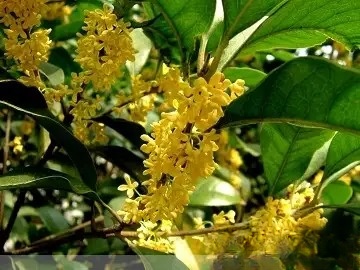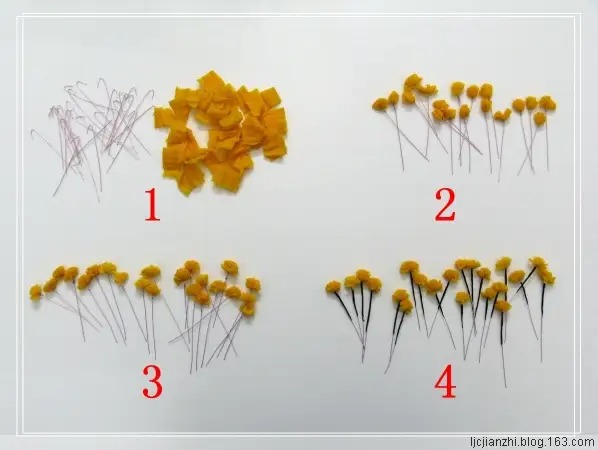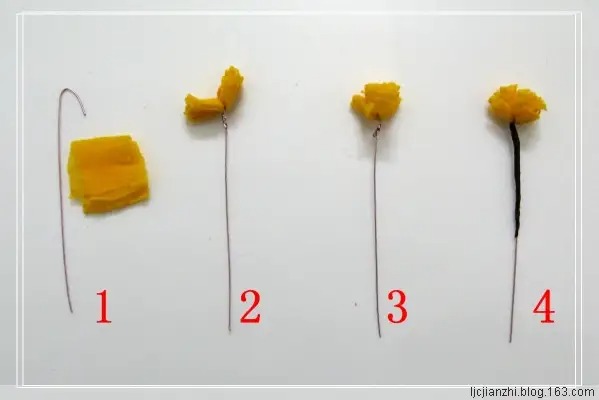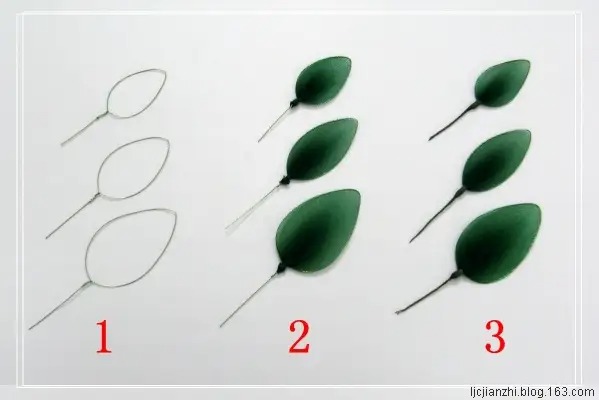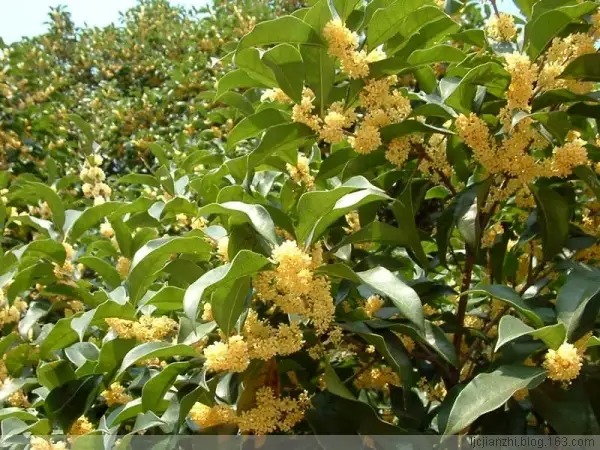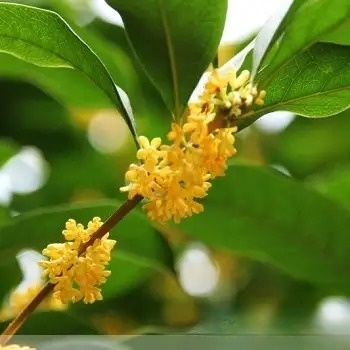How to make silk screen flowers
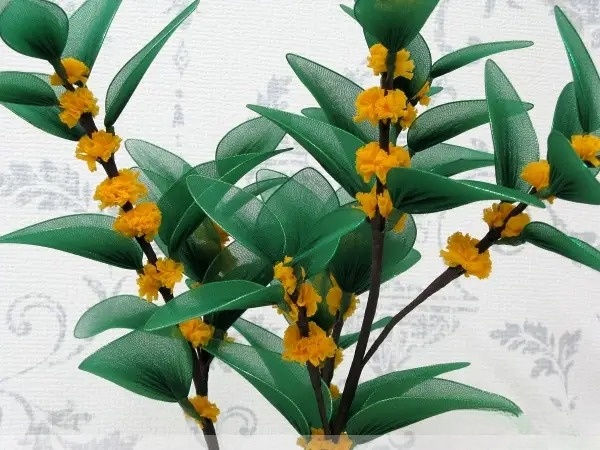
Silk screen flower "Golden Osmanthus" by Ye Yingchun
Golden Osmanthus Information
|
| Golden osmanthus is a kind of sweet-scented osmanthus. "In August, sweet-scented osmanthus is everywhere, and it dominates the three autumns and surpasses all other flowers." Every Mid-Autumn Festival, when the moon is bright and the sweet-scented osmanthus is in full bloom, the air is permeated with the sweet fragrance of sweet-scented osmanthus. The eighth month of the lunar calendar was called Guiyue in ancient times. This month is the best time to appreciate sweet-scented osmanthus and the best month to appreciate the moon.
2. As shown in the figure: 1. Take a 26# iron wire (about 10 cm) elbow and cut a half section of wire mesh (about 2 cm) 2. Clamp the iron wire in the middle of the wire mesh and tighten it 3. Cut the wire mesh head into pieces and trim it into shape 4. Wrap it with brown tape
3. How to make leaves: 1. Make several circles with 24# iron wire, 5# and 6# sleeves; make several circles with 22# iron wire and 7# sleeves (all with long handles) 2. Wrap with green wire mesh 3. Wrap with green tape
4. 1. Wrap the two small flowers and two leaves together with brown tape. 2. Take 1/3 (about 27 cm) of 24# wire elbow and wrap it around the second layer of small flowers and leaves. 3. Assemble as shown, and then add 2# flower rods (use brown tape for both).
Assemble 3 to 5 pieces as shown above.
Put the flower branches into the vase and the golden osmanthus is ready. When the sweet osmanthus has not yet smelled its fragrance, when the earth has not yet changed into the color of autumn, why not make a few branches of golden osmanthus by yourself, and savour the tranquility and nature that belongs only to you in the misty mornings, in the drizzling days, and in the bright moonlit nights?
Silk screen flower "Forget-me-not" made by Ye Yingchun
Forget-me-not information
Forget-me-not is a direct translation of the English name "Forget-me-not". The name of this flower is quite romantic, and the legend about it further confirms its status as the "love flower". According to legend, a knight in ancient Europe paid the price of his life to pick a bunch of flowers for his beloved girlfriend, and this flower is "Forget-me-not". Forget-me-not is a species of Boraginaceae, an annual or biennial herb with a stem height of 10 to 50 meters. Especially in the wild, it is very small and delicate, and the flowers are blue-purple. There are variants of white forget-me-not and red forget-me-not. Young men and women give each other forget-me-nots to express their deep affection.
In the current flower market, there is a flower called "Forget-me-not". It can last for a long time. The flower is membranous and has purple, lavender, rose pink, blue, red, white and yellow varieties. In fact, it is not Forget-me-not, but Limonium. Calling Limonium "Forget-me-not" is actually a misnomer. But the name "Forget-me-not" is indeed very touching. It is because people cherish this emotion that it is understandable to mistakenly call other flowers "Forget-me-not".
Forget-me-not flower language
The production of silk screen flower "Forget-me-not"
1. Prepare materials: You need to prepare the materials first, including blue, purple and other colored silk screens, 20# and 26# iron wires, green tape, etc.
2. As shown in the figure: 1. Take a 26# iron wire (about 10 cm) bend and cut a piece of wire mesh (about 3 cm) 2. Clamp the iron wire in the middle of the wire mesh and tighten it 3. Cut the wire mesh head into pieces and trim it into shape 4. Wrap it with green tape
3. Take 1/3 of the wire elbow (about 27 cm) 2. Wrap the wire and small flowers together with green tape 3. Add small flowers in a left-right alternating pattern to make a bouquet (9 or 11 on the top layer, 7 or 9 on the middle layer, and 5 or 7 on the bottom layer) 4. Take another 20# wire (80 cm) for the top layer, fold it in half and wrap it around to replace the flower stem 5. Add the bouquet in a left-right alternating pattern, and cut thin green tape to make leaves Make a few more branches and you can make a bottle.
As soon as I finished making the forget-me-nots, my baby daughter couldn’t wait to take a photo with the flowers…
The light forget-me-not has a unique elegance. I prefer this poetic name. When I call out "forget-me-not", I suddenly feel a faint sense of melancholy and tenderness. But I wonder if "forget-me-not" is changed to "forget-me-not", and the demand and dedication are exchanged, will it be more touching?
Silk screen flower "Hanging bell" made by Liu Jincai
Fuchsia Information Fuchsia is a perennial shrub. When it blooms, its flowers hang down in graceful postures, like hanging colorful lanterns. Potted plants are suitable for decorating living rooms, flower stands, and desks. If you put them in a vase with clean water, they can be used for viewing and for rooting and reproduction. Fuchsia is also known as hanging bell begonia, lantern begonia, hanging bell flower, and in Guangdong it is also called Baoliandeng. It is an evergreen shrub of the Onagraceae family and the genus Fuchsia. It can reach 1 meter in height. The stem is smooth, the branches are thin and slightly drooping, and are often purple-red. The leaves are opposite or three-leafed, with short petioles, ovate-lanceolate. The flowers are solitary in the leaf axils, and the pedicels are about 5 cm long and drooping; the calyx tube is oblong, the sepals are 4-lobed, radially located below the corolla, and the corolla is upside down and bell-shaped, hence the name. The stamens and pistils are higher than the corolla, like the hanging whiskers of a lantern.
There are many varieties and hybrids of fuchsia, such as "Cover Girl": double flowers, bright red calyx, blue-purple petals; white-calyx fuchsia has milky white calyx and pink petals; single-petaled fuchsia has single petals, magenta sepals and white corolla; "Winston Churchill" fuchsia has larger red sepals and blue-purple corolla, which is beautiful and noble.
Fuchsia Flower Language The flower shape of fuchsia is peculiar, the color is rich, luxurious and gorgeous, it is a rare indoor flower, very popular with the public. Its flower language is "warm heart".
The production of silk screen flower "Fuchsia"
1. Prepare materials: You need to prepare the materials first, including colored silk screens, small pearlescent flower cores, 26# iron wire, 2# flower rods, green, white and red tapes, etc.
2. How to make the petals: 1. Make 4 petals with 2# and 4 petals with 4# as shown in the picture 2. Pinch them into the shape shown in the picture above 3. Put the silk screen on them respectively, 2# with single layer and 4# with double layer
3. Single flower assembly: 1. Take a 26# iron wire with a 20cm elbow and clamp 4 flower cores (3 of which are folded in half, and 1 is slightly longer at one end) 2. After cutting off the shortest end of the flower core, wrap it with white tape 3. Add 2# petals, and the flower core must be exposed 4. After adding 4 2# petals in sequence, wrap it with red tape 5. Add 4# petals as shown 6. After adding 4 4# petals in sequence, wrap it with green tape 7. Wrap QQ line around the waist 8. Shaping, done
4. How to make the small and large flower buds: 1. Clip a small amount of broken wire mesh at the elbow of 26# iron wire about 20 cm 2. Wrap it tightly and put on two layers of light green wire mesh 3. Wrap with green tape, and the small flower buds are completed 4. Take the broken wire mesh and wrap it into a ball shape, and make 4 pieces of 1# light green petals 5. After adding petals one by one, wrap another layer of light green wire mesh 6. Wrap with green tape, and the large flower buds are completed
5. Flower bud method: 1. Make a flower bud and make 4 petals with 4# double-layer silk screen. 2. Wrap the root of the flower bud with red tape and add 4 petals in sequence. 3. Wrap green tape and wrap QQ wire around the waist to shape it.
6. Leaf making method: 1. Take 26# iron wire and make 2#, 3#, 4#, 5# circles, leaving a long handle 2. Pinch into the shape shown above 3. Put on green silk screen and wrap with green tape
7. Prepare all kinds of "parts"
8. Single branch assembly, with half a 2# flower stem attached to the root
Combine all the individual branches together and the beautiful fuchsia is ready!
Gardening
Flower Gardening
Silk screen flower "Alice" made by Liu Jincai
Alice Information Alice's real name is iris, which is named after its petals, which are shaped like a kite's tail. Its genus name, iris, means "rainbow" in Greek, which refers to the rich colors of the flower. Generally, flower dealers and flower arrangers call it "Alice" based on the transliteration of its genus name.
Alice is blue-purple in color, and its shape resembles a dancing butterfly. In May, when Alice flowers bloom, you can see blue butterflies flying among the green leaves, as if they are spreading the news of spring to faraway places. The French regard the iris as their national flower because according to legend, when Clovis, the first king of the French Kingdom, was baptized, God gave him a gift, which was the iris. In France, the iris is a symbol of light and freedom. Alice grew up in Japan, Siberia and almost the entire temperate world. In Greek mythology, Alice is the goddess of the rainbow. She is the messenger between the gods and the mortal world. Her main task is to bring the souls of good people back to heaven through the rainbow bridge between heaven and earth after their death. To this day, Greeks often plant this flower in cemeteries in the hope that the soul of the dead can be entrusted to Alice to take back to heaven. This is also the origin of the flower language "messenger of love". Iris represented "strength" and "eloquence" in ancient Egypt. Israelis generally believe that yellow irises are a symbol of "gold", so there is a custom of planting irises in cemeteries in the hope that they will bring wealth to the afterlife.
Alice Flower Language The colorful Alices represent different meanings: White irises represent innocence, yellow represents everlasting friendship and enthusiasm and cheerfulness, blue represents admiration for the other person's elegance and generosity or secret admiration, and purple represents love and auspiciousness.
The Making of Silk Screen Flower "Alice"
1. You need to prepare the materials first: 20#, 24#, 26# iron wires; wire meshes of various colors; green tape, etc.
2. How to make the petals: 1. Make three 2#, 4#, and 6# circles as shown in the picture (4# and 6# circles can also be made into wavy shapes) 2. Pinch them into the shapes shown in the picture above 3. Put the silk screen on each
3. How to make leaves: 1. Use (6+8)# sleeve and 20# iron wire to make a loop (leave a long handle) 2. Pinch into the shape shown above 3. Put on a layer of light green silk screen first 4. Put on a layer of dark green silk screen and make 4 pieces
4. Assembly: 1. Take half a 20# wire (about 40cm) and bend it 2. Add 3 4# petals in sequence 3. Wrap the 2# petals and 6# petals one by one, and assemble them in sequence 4. Wrap with green tape and add leaves in sequence
5. The appearance of a single branch assembly
Make a few more branches to form a bouquet.
Silk screen flower "Fusang" made by Liu Jincai
Fuso Information In the south, beside ponds, pavilions, roadsides and walls, you can often see brightly colored hibiscus flowers, which bloom in the morning and wither in the evening. Hibiscus is also known as hibiscus, or a flower that blooms in the morning and withers in the evening. Each flower blooms for only a short day.
Hibiscus is the national flower of Malaysia and Panama, and the state flower of Hawaii. However, the origin of hibiscus is in Taiwan, and it has a long history of cultivation. As early as the Han Dynasty, the "Classic of Mountains and Seas" recorded that "there are hibiscus in Tanggu", and Ji Han's "Southern Plants" in the Jin Dynasty recorded that "its flowers are like hibiscus but the color is deep red, so it is called hibiscus", "deep red, with five petals", etc. There are many varieties of hibiscus, and they are colorful. According to the petals, they can be divided into single petals and double petals, and according to the color, they can be divided into pink, yellow, green, white, etc. Among them, the deep red double petals are slightly similar to peonies, but are not common, so they are named hibiscus peonies.
The brightly colored flowers and dark green leaves of the hibiscus make it look very bright and harmonious. What a strong and fierce flower it is! The open flower shape seems to be telling something. Although each hibiscus flower blooms for only one day, another bud will bloom after one bud withers. This vigorous energy keeps the hibiscus in its freshest state. The hibiscus, originally from Hawaii, has now become the representative of Hawaii. It is because it blooms for only one day that southern girls like to use it to decorate their long black and shiny hair. Under the shining golden sunlight, every southern girl with a hibiscus in her hair is looking forward to the early appearance of her lover!
Hibiscus Flower Language Immerse yourself in the romantic atmosphere of Hawaiian hibiscus flowers. Fresh love, delicate emotions, blue sea and sky, beautiful Hawaiian girls. The southern beauties always have a passionate hibiscus flower next to their ears, and the beautiful hibiscus flower language represents the unrestrained emotions in the heart, trust you, and ever-fresh love.
The production of silk screen flower "Fusang"
1. Prepare materials: You need to prepare the materials first, including various colored silk screens, red medium-sized pearlescent flower cores, yellow small-sized pearlescent flower cores, 20# 24# 26# iron wires, 2# flower rods, red and green tapes, etc.
2. Make the flower core: 1. Take a 20cm elbow of 24# iron wire and clamp 3 red flower cores 2. After wrapping with red tape, cut off one flower core along the root 3. Add 6-8 yellow flower cores and wrap them tightly with QQ thread 4. Fold the other half of the yellow flower core upwards, wrap it with QQ thread and wrap it tightly with red tape 5. Add 4 yellow flower cores in turn and wrap them tightly with red tape
3. Winding: 1. Take a 24# iron wire 2. Wind it around a packing needle or a knitting needle and straighten it 3. Use a 6# sleeve to make 5 circles and pinch out the shape shown above
4. What you need for a flower: 1. A 20# iron wire as a stem 2. 5 pieces of 6# circle petals (24# wire wavy type) 3. 5 pieces of 2# circle calyx (26# wire standard type) 4. A flower core
5. Single flower assembly: Tie the 20# wire elbow to the flower core, install the petals in the correct position, and the calyx in the reverse position. Finally, wrap them with green tape. The assembly should look like the following:
Six, large flower bud method: 1. 5 pieces of 5# circle petals (24# standard silk) 2. 5 pieces of 2# circle calyx (26# standard silk) 3. The flower core method is the same (slightly less yellow flower core: about 4 per layer) 4. Put the petals upright and the calyx inverted, wrap with green tape
7. How to make small flower buds: 1. Use 24# wire elbow to crush the wire mesh and wrap it with light green wire mesh. Prepare 26# wire 3-4# to wrap 3 petals. 2. After adding the petals, wrap another layer of light green wire mesh. Prepare 26# wire 1# to wrap 5 calyxes. 3. After putting the calyx in place, wrap it tightly with light green tape.
8. Several 2-6# circle leaves (leave long handles, 2#2, 3, 4# can choose 26# iron wire, 5#6# can choose 24# iron wire)
9. Pruning and assembling...
In this way, the passionate and charming Fuso is completed! The early chill in the creek pavilion feels like early spring, and the red flowers lean against each other, charming passers-by. It’s a pity that all the trees are withered, only the lush branches are blooming again. The pure and beautiful fragrance is revealed on clothes, and the subtle fragrance passes through the dusty tracks. The famous gardens refuse to compete for beauty, and the wild Fusang trees are dazzling by the water.
Silk screen flower "Lily of the Valley" by Liu Jincai
Lily of the Valley Information Beside the path in the dense forest, The lilies of the valley are in bloom. The wind shakes them like strings of white jade bells. I think there will be tinkling sounds in the forest when the leaves fall. Jingle, jingle, jingle, jingle, The fragrance is so fragrant. …… This is a lyric describing lily of the valley. Lily of the valley is also called Junying grass, which is a perennial herbaceous plant of the genus Convallaria of the Liliaceae family. Lily of the valley likes a warm, cool, refreshing and humid environment, so it always grows in the valley under the forest in the wild. Hidden in the mountains, the flowers bloom fragrantly, which is similar to the character of orchids that hide in the mountains and do not lose their fragrance even when there is no one. In ancient times, lily of the valley was a representative of noble character. The phrase "A gentleman should be like an orchid" is both an encouragement and a praise. It's just that when we miss such a gentleman, we see the lily of the valley grass, Junying grass, Junying grass, and when we call him, we have the gentleman in our hearts!
There is a beautiful legend in Ukraine, saying that a long time ago there was a beautiful girl who waited for her lover who was away on an expedition. Her tears of longing fell on the grass in the forest and turned into the fragrant lily of the valley. There is also a legend about a boy named "Lily of the Valley" who was heartbroken because his lover "Spring" left him. The boy's tears turned into white flowers, and the blood from his broken heart turned into the bright red berries of the lily of the valley. Lily of the valley is the flower of the sunrise goddess in ancient Nordic mythology. It is a flower dedicated to the sunrise goddess. Lily of the valley is also a sacred flower for North American Indians. The romantic French have a special "Lily of the Valley Festival". On the "Lily of the Valley Festival" in May, the French give each other lily of the valley flowers, which symbolize auspiciousness and good luck.
Lily of the valley Just like the sad legend of the birth of lily of the valley, the happiness of lily of the valley will come with extra difficulty and be accompanied by a vague sadness of fate. The waiting of lily of the valley is like the sigh of stars in the wind, vague and quiet, only those with a heart can feel it; the temperament of lily of the valley is as pure and clear as the faith of the steadfast and gentle love of the woman in the wind, only those who concentrate can taste it. If you can't catch the faint fragrance of lily of the valley, as light as the sigh of stars, from the night wind, how can you follow the fragrance to the valley where lily of the valley blooms? If you don't protect it with all your heart, how can you walk to it at the right time? Lily of the valley waits only for the most caring people, and the music of lily of the valley knocking in the wind can only be heard by those who love it the most. In order to get true love, lily of the valley waits for the arrival of its own spring in the lonely valley... Lily of the valley only blooms with the spring breeze in May. Her flower language is return of happiness. Lily of the valley is the national flower of Finland, Sweden, and Yugoslavia, and can often be seen at weddings in France. Giving this flower to a bride is a way to congratulate the newlyweds on their arrival. This is probably because the bell-like flower reminds people of a bell that evokes happiness. In friendship, lily of the valley has always been used to express the pride of "happiness, purity, and virginity," and good wishes such as "happiness is bestowed on innocent girls."
The Making of Silk Screen Flower "Lily of the Valley"
1. Prepare materials: You need to prepare the materials first, including white, light green, green silk screen, cotton, small pearlescent flower core, 20#, 26# iron wire, 2# flower stem, white, green, light green tape, etc.
2. Ring: 1. Prepare 26# iron wire and 1# sleeve 2. Make 6 rings 3. Pinch into the shape shown above
3. How to make petals: 1. Prepare some cotton and 1# ring 2. Wrap the 1# ring with cotton 3. Put on the white silk screen and wrap it tightly with QQ thread 4. Make 6 petals for one flower
4. Single flower assembly: 1. Bend a 26# iron wire (about 20 cm) and prepare 2 small pearlescent flower cores. 2. Fold the small pearlescent flower core in half, and wrap the iron wire bend close to the root of the flower core with QQ thread. 3. Add petals and turn it upside down. 4. Add three pieces first. 5. After adding three more pieces, wrap the head (under the flower core) tightly with white tape. 6. Fold the petals upwards and pinch out the flower shape (as shown below). 7. After wrapping with light green tape, bend the flower stem.
(Flower shape as shown above)
5. Flower bud method: 1. Prepare some broken wire mesh, take a 26# iron wire (about 20 cm) elbow, and clamp the broken wire mesh 2. First: Wrap two layers of white wire mesh first, then wrap two layers of light green wire mesh 3. Second: Wrap two layers of light green wire mesh first, then wrap two layers of white wire mesh
6. How to make small leaves: 1. 1# sleeve, 26# wire 2. Leave a long handle 3. Pinch into the shape shown above 4. Put on two layers of light green wire mesh 5. Wrap with light green tape
7. How to make the big leaf: 1. 20# iron wire 2. 7#+8# sleeve 3. Pinch into the shape shown above 4. First put on a layer of light green silk screen 5. Then put on a layer of dark green silk screen
8. After all the "parts" are made, start assembling.
The difficulty of making this flower lies in the arrangement of cotton and flower shape. Although the process of making lily of the valley is very hard, when so many traces worth cherishing have disappeared in the years, disappeared in the wind and clouds, watching the beautiful lily of the valley being born in your hands, such a feeling of success and happiness is worth your eternal waiting for it. To be honest, I have a special liking for lily of the valley. Its white flowers hanging like bells are pure and noble, floating and intoxicating. The beautiful lily of the valley is like an innocent girl in the mountains, romantic and elegant, and affectionate... Beside the path in the dense forest, The lilies of the valley are in bloom. It's like someone has scattered the distant stars onto the ground. I think there will be sparkles in the forest grass at night, There will be sparkles in the grass. Starlight, starlight, starlight, Fascinating. ……
Silk screen flower "Ocean Orchid - Cattleya" produced by Liu Jincai
Oceania Orchid Information Cowrie orchid is a general term for orchids distributed in tropical and subtropical areas, such as Cattleya, Dendrobium, Oncidium, Phalaenopsis, Paphiopedilum, etc. They are both orchids, but they are divided into two groups: Chinese orchids and foreign orchids. Orchids are elegant and beautiful, with a faint and long-lasting fragrance; foreign orchids are graceful and beautiful. Compared with orchids, foreign orchids have peculiar shapes, bright colors, and large flowers, which have a sense of wealth, so they are called oceanic orchids.
Compared with Chinese orchids, the cultivation history of foreign orchids is very short. In 1737, Swedish botanist Linnaeus first created the plant classification system, initially dividing orchids into 8 genera and 21 species. In 1759, the Royal Botanic Gardens in London was established in the UK to conduct cultivation experiments on more than 100 types of foreign orchids. In 1838, foreign orchids entered the United States and were then tested in the Netherlands, attracting the attention of Southeast Asian countries. Singaporeans are particularly fond of "orchids" (i.e. tropical orchids), and many flower merchants are actively engaged in production and operation. Malaysia, Thailand and other countries have also encouraged the development of foreign orchids.
Nowadays, more and more Chinese people are fascinated by orchids and their brilliant and gorgeous flowers. Although orchid varieties such as cymbidium, phalaenopsis, and cattleya are expensive, their unique flower shapes and gorgeous flowers have attracted countless favors and have become the jewel in the crown of orchid lovers.
Ocean Orchid Language Flower language: respect, admiration, pure love. Red, pink, orange and purple represent true love and admiration.
Production of Silk Screen Flower "Ocean Orchid" 1. Prepare materials: You need to prepare the materials first, including wire mesh of various colors (must have green), 20# iron wire, 24# iron wire, 26# iron wire, 2# flower rod, green tape, etc.
2. Winding: 1 piece of 26# iron wire 2# sleeve (leave a long handle), 3 pieces of 24# iron wire 5# sleeve, 3 pieces of 24# iron wire 7# sleeve
3. Reinforcement: 1. Take a 26# iron wire and a 5# ring 2. Pinch the 5# ring into the shape shown above 3. Insert the iron wire into the ring 4. Fold the lower part of the iron wire upwards and the upper part downwards 5. Tighten the root
4. Reinforcement: 1. Take a 26# iron wire and a 7# ring 2. Pinch the 7# ring into the shape shown above 3. Insert the iron wire into the ring 4. Fold the lower part of the iron wire upwards and the upper part downwards 5. Tighten the root
5. Put all the prepared traps on the wire mesh.
6. Single flower assembly: 1. Take a 2# flower stem and add a 2# ring as shown in the picture 2. Add a 7# ring in the opposite direction of the 2# ring 3. Add another 2 7# rings to form a triangle 4. Add 3 5# rings between the 7# rings, add 2 more 2# flower stems, and wrap them with green tape.
6. Leaf method: 1. Prepare a 20# iron wire and a 24# iron wire 2. Use 20# iron wire and 7#+8# sleeve to make a circle 3. Pinch the circle into the shape shown above 4. Use 24# iron wire for reinforcement 5. Put on the wire mesh and wrap it with green tape
Make a few more flowers, add a dozen large leaves, and combine them, and you will have a beautiful orchid in your hands! The key to this flower is the iron ring reinforcement technique.
Silk screen flower "Dropping Orchid" by Liu Jincai
Information about the orchid Chuiliao is a type of hyacinth, with slender and flowing leaves and jade-like flowers, giving off a pure and clean feeling. There are many varieties of Chuiliao, with hundreds of species, each with its own shape and posture. Take the flowers for example, each pot of Chuiliao has more than ten flower spikes full of buds, and dozens of colorful green buds fall vertically like a waterfall, which is very gorgeous and beautiful. I like the beauty of the one that bows its head like a graceful girl, shyly telling her thoughts...
Weeping orchids originated in Japan, New Zealand and the United States, and are very popular among local consumers. They are sold at a high price. Four years ago, they were introduced from Japan and immediately became the new star and favorite in the New Year flower market, and a good gift. It is reported that the price of Japanese weeping orchids is relatively high because the shaping time is as long as half a year, and the packaging and shipping costs are high. The general container can hold 2,000 pots of flowers, while the precious Japanese weeping orchid can only hold 245 pots, so the price is 3 to 5 times higher than that of ordinary imported flowers. Despite the high price, they are often sold out.
Weeping orchids are bred by hybridizing the native species of weeping orchids with the upright cymbidium orchids. Diwang orchids, multiflora orchids, and wetland orchids are the commonly used parents of weeping orchids currently cultivated. There are abundant native species of drooping flowers in the genus Orchidaceae, such as multi-flowered orchids, petaled orchids, winter orchids, hard-leaved orchids, and red-column orchids. Except for winter orchids that bloom in winter, most of these native species bloom in spring and summer, but the flowers are small, the flower shape is poor, the flowering period is short, and the direct commercial value is not high. By hybridizing with large-flowered varieties that have been improved through multiple generations of hybridization, combining the characteristics of large-flowered varieties such as tolerance to blooming, beautiful flower shape, and large flowers with the drooping flowers, strong disease resistance, easy planting, flowering, or fragrance of the drooping flower original species, new varieties with great market prospects will be bred. Therefore, there should be great achievements in the breeding of drooping flower cymbidiums.
The production of the silk screen flower "Drop Orchid"
1. Prepare materials: You need to prepare the materials first, including 3 colors of silk screen (you can match the colors yourself), 22# and 26# iron wire, special leaves, light green tape, etc.
2. Take a 26# iron wire, make 5 4# loops first, and use the remaining wire to make 1 2# loop, leaving a long handle.
3. Winding: 1. Take another 26# wire 2. Wind it around the baling needle or knitting needle 3. Wind it into a spring shape 4. Straighten it 5. Use a 5# sleeve to make a circle
4. Pinch the wound circle into the shape shown above.
5. Put on different colored screens respectively.
6. Single flower assembly: 1. Put the 2# petal and the 5# petal face to face and wrap them tightly with QQ thread 2. Take a 4# petal close to the 2# petal and wrap it tightly 3. Take 2 4# petals close to the 5# petal and wrap it tightly 4. Put the last 2 4# petals close to the 4# petals of the first assembly and wrap them tightly 5. Wrap the whole branch with light green tape
7. How to make flower buds: 1. Take half a 22# wire elbow and prepare some broken wire mesh. 2. After clamping the broken wire mesh on the elbow, put on two layers of pink wire mesh. 3. Add 1-2 layers of light green wire mesh and wrap it with light green tape. 4. To make a half-bloom, add 2-3 4# petals on the basis of the flower bud.
6. Branch assembly: Wrap the flower buds, half-blooms and full blooms with light green tape in turn.
7. Make more branches. It takes a lot to make a beautiful weeping orchid! Be patient!
Just put them together and it's done! Do you like it?
Silk screen flower "Meconopsis" made by Liu Jincai
Meconopsis information In northwest Yunnan, which is known as the "natural garden", on the high mountains and in the snow-capped valleys, when the temperature rises and the snow begins to melt, the rain and dew nourish the snow grass, which is full of vitality. In the green and lush grass, all kinds of flowers bloom. Among these colorful sisters of flowers, the light and charming Meconopsis, dancing gracefully, is particularly eye-catching. When it comes to Meconopsis, many people are naturally unfamiliar with it, because it lives in the valleys of high mountains and cannot be found in ordinary plains or hills, and even in town gardens. However, anyone who sees its beauty will be fascinated by it. There are 49 species of Meconopsis in the world, mainly produced in central and southern Asia, with Meconopsis being the most abundant, accounting for 38 species; distributed in Tibet, Yunnan, Sichuan, Qinghai, Gansu, Shaanxi, Hubei and other provinces. There are 17 species in Yunnan, concentrated in snow-capped mountain meadows, alpine shrubs and gravel beaches above 3,000 meters above sea level in northwestern Yunnan. A few species extend to the subalpine zones in central and northeastern Yunnan.
Meconopsis is an annual or perennial herb, with a plant height ranging from 2-3 inches to 3-5 feet. Different species have different flower shapes and postures: some have scapes that emerge from the rosette-shaped leaves at the base, with several scapes in a cluster and each scape standing alone; some have flowers on stems, with several flowers on a stem, forming a racemose panicle. Most of the petals are four, but there are also double petals with up to ten petals. The leaves are oblong, broadly ovate, or have long handles like spoons, or split into lyre shapes, etc. Many species have soft and long hairs on their bodies, which gave them the elegant name of "Meconopsis". At first glance, the beautiful Meconopsis seems to leave people with an impression of being extremely delicate and fragile. In fact, it is a strong fighter with a strong character and is not afraid of severe cold and wind. Anyone who has been to the snow-capped mountains knows the climate characteristics of high-altitude areas: cold frost, strong radiation, strong winds and thin soil, large temperature differences between day and night, and great climate changes. Even in the warm summer when the snow melts, there are sometimes clear skies and sometimes sudden rains and hail. Generally, trees cannot grow well, and herbaceous plants and small shrubs often form mats and crawl on the ground. However, Meconopsis can grow tenaciously in such a harsh environment. In order to adapt to the severe climate, they are covered with plush, as if wearing a sweater to keep warm; the roots also become thick and tough, and their length is often several times longer than the height of the plant, so that they can penetrate the cracks in the rocks to root deeper and accumulate more nutrients. What is even more amazing is that in the barren and rocky beach at an altitude of 5,000 meters, it can stand tall and bloom gorgeous flowers. Yes, it has a beautiful appearance, but its character is strong. It is both strong and gentle, and has excellent character. This is the true nature of Meconopsis. It is a pity that such outstanding and rare flowers as Meconopsis, Primula, Gentiana, and Rhododendron have long been buried in the mountains. In recent years, the Kunming Institute of Botany of the Chinese Academy of Sciences has begun to systematically investigate these precious alpine flowers; the Lushan Botanical Garden, surrounded by clouds and beautiful scenery, has also begun to introduce and domesticate these famous flowers. May the alpine flowers of Yunnan multiply and flourish on the vast land!
Meconopsis flower language Tenacious vitality
The production of the silk screen flower "Meconopsis"
1. Prepare materials: You need to prepare the following materials first, including blue and green silk screen; 22#, 24#, 26# iron wire; large pearlescent flower core, small pearlescent flower core; green tape, etc.
2. Winding: 1. Take a 26# iron wire 2. Wind it around a packing needle or a knitting needle 3. Use a 4# sleeve to make 4 circles, and tighten the iron wire joint with pliers
3. Put the finished trap on the wire mesh, and prepare half a 24# iron wire, about 20 small pearlescent flower cores and one large pearlescent flower core.
4. Legend: 1. Bend the 24# iron wire and clamp the large pearl flower core 2. Wrap it with green tape 3. Wrap the small pearl flower core around the large pearl flower core and tighten it with QQ thread 4. Fold the other half of the small pearl up and tighten it with QQ thread, then add petals 5. Add 4 petals in turn and tighten them with tape. A flower is done!
5. How to make the flower buds: 1. Prepare half a 24# iron wire and some broken wire mesh. 2. Clamp the broken wire mesh with the iron wire elbow. 3. Wrap it into a mallet shape with QQ wire. 4. Wrap the elbow with green tape.
6. How to make leaves: 1. Take a 22# iron wire 2. Wrap it with an 8# wire 3. Leave the wire head longer 4. Pinch it into the shape shown above 5. Put on the wire mesh (single or double layer) and wrap it with tape.
Assemble the flowers, buds and leaves, and a fresh and elegant pot of Meconopsis will be born! Can you do it?
Silk screen flower "Tulip" produced by Liu Jincai
Tulip Information The Garden of Western Europe - the Netherlands, is known as the "Land of Tulips". Tulips, windmills, cheese and wooden shoes are known as the "Four Treasures of the Netherlands". The Dutch people have always regarded them as a symbol of beauty, luxury and solemnity. The origin of tulips is the Qinghai-Tibet Plateau. They were introduced to Central Asia more than 2,000 years ago. In the 16th century, an Austrian envoy stationed in Turkey brought them to Europe, and since then, tulips have become popular in Europe. The Dutch regard tulips as gold, and the number of these flowers they own is a symbol of their wealth.
Precious black tulips (thanks to Jiangshan Ruhua for providing the picture) In 1977, when Queen Beatrix of the Netherlands visited China, she presented tulips to the people as an elegant gift, which became a symbol of friendship between the Chinese and Dutch people. These flowers have been planted in Zhongshan Park in Beijing. Other countries that have tulip as their national flower include Hungary, Türkiye, Iran and others. Tulip belongs to the family: Liliaceae, Tulipa. It is a perennial herb. The bulb is flat and oval, and the stems and leaves are smooth and covered with white powder. There are 3-5 leaves, which are broadly lanceolate and basal. The flower stem is 6-10 cm high, with a large bell-shaped or funnel-shaped flower on the top, which can be single or double petals. Tulip species: There are many cultivated varieties, more than 8,000. The flower shapes include cup, bowl, egg, ball, lily, double petals, etc. The flower colors include white, pink, purple, brown, yellow, orange, etc., with different shades, single or multiple colors. The flowering period is early, mid-term, and late. Although there are many varieties, like hyacinths, it is difficult to cultivate successfully in many places and often degenerates.
Tulip Flower Language What do tulips represent? In ancient Roman mythology, tulips are the daughter of the god Brat. In order to escape the unrequited love of the god of autumn Belzinus, she asked the god of chastity Diana to turn herself into a tulip. Therefore, one meaning of wild tulips is chastity. Of course, different colors of tulips have different meanings: Tulip: Confession of love, honor, eternal blessing Tulip (red): declaration of love, joy, passion Tulip (pink): beauty, love, happiness Tulip (yellow): noble, precious, wealth Tulip (purple): Endless love, favorite Tulip (white): innocence, purity Tulip (two-color): Beautiful you, happy meeting
The Making of Silk Screen Flower "Tulip" 1. Prepare materials: You need to prepare the materials first, including colored silk screens, flower cores, 24# iron wire, 2# flower rods, three-pronged heads, green tape, etc.
2. Winding: 1. Take a 24# iron wire 2. Wind it around a packing needle or a knitting needle 3. Wind it into a spring shape 4. Straighten it 5. Use a 6# sleeve to make 6 circles, and tighten the wire joint with pliers
3. Pinch the wound circle into the shape shown above.
4. Illustrations: 1. Put the pinched loop on the wire mesh and wrap it with QQ thread. Just pull the QQ thread end and the tied head will not fall apart easily. 2. Prepare 3 flower cores and 1/3 2# flower rods. 3. Bend the flower rods and clamp the flower core. 4. Wrap with tape.
5. Single flower assembly: 1. Add petals as shown and wrap them tightly with QQ thread 2. First install 3 pieces to form a triangle 3. Add a petal between every two pieces, and add the other three pieces
6. Pruning assembly: 1. Align the single flower with the three-pronged head 2. Insert the flower stem 3. Wrap with tape
In this way, a whole branch of tulips is ready! It's very simple, right? I believe you can do it!
Make a few more branches and make a bunch, how beautiful! It is a great choice for decorating your home or giving to relatives and friends! |
